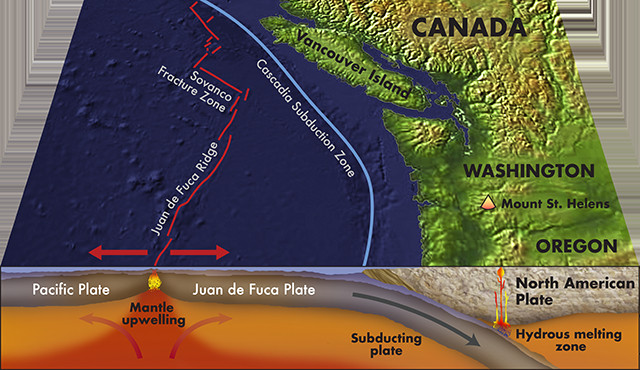
by Mary Caperton Morton Tuesday, March 22, 2016

A new study using seafloor seismic instruments has revealed more information about the complex and dangerous Cascadia Subduction Zone. Credit: K. Cantner, AGI.
The Cascadia Subduction Zone (CSZ), off the Pacific Northwest coast of the United States and Canada, is one of the world’s most mysterious — and potentially dangerous — earthquake zones. Eerily quiet since a massive magnitude-9 event in 1700, scientists have long warned that the 1,000-kilometer-long fault zone could produce another devastating earthquake and tsunami. Now, a new effort to map the fault zone’s tectonic environment, including the underlying mantle, is shedding light on some of the dynamic forces that may influence earthquakes in the region.
Since 2012, the University of Oregon-led Cascadia Initiative has deployed seafloor seismometers at 120 sites across the Juan de Fuca Plate, which dives under the North American Plate off the coast of Washington state, forming part of the CSZ. The instruments span the entire 500-kilometer-wide plate, providing the most detailed look yet at interactions between the plate and underlying mantle.
The goal of the Cascadia Initiative “is to understand large-scale plate tectonic processes in order to link them all the way down to specific earthquakes in the Pacific Northwest,” says Richard Allen, a seismologist at the University of California at Berkeley and lead author of a new study in Nature Geoscience
Previous experiments have relied on onshore seismic instruments to peek at the mantle, but deploying instruments directly on the seafloor presents a clearer picture. “The offshore environment is much simpler, the plates are thinner and more uniform than continental plates and we can see through them to get a better sense of what is going on beneath,” Allen says.
Three years of data revealed that the mantle under the Juan de Fuca Plate is flowing eastward, in the same direction as the plate. But “we don’t know if the plate is moving and dragging the mantle with it, or if the mantle is flowing in that direction and pulling the plate with it,” Allen says. “All we know at this point is that they’re aligned.” The finding is consistent with existing models of plate motion and mantle flow, but “this is the first time that we’ve been able to observe it in the field,” he says.
A more surprising finding came when the team analyzed data recorded from the Gorda Plate, a smaller section of the Juan de Fuca Plate located at the southern end of the CSZ. “We would have expected the flow under the Gorda Plate to be the same as the flow under the Juan de Fuca, but in fact, it’s different,” Allen says. Instead of also flowing east under the Gorda Plate, the mantle flows northwest, in alignment with the Pacific Plate, which surrounds the Gorda Plate to the west and south.
“Our interpretation is that the Gorda Plate is too small to couple to the mantle below, which tells us something about the scale of mantle-plate relationships: It seems that the Juan de Fuca, which is a medium-sized plate, is big enough to couple to the mantle, but the Gorda Plate is not,” Allen says.
“This is some of the first documentation we have that could place limits on the critical size for mantle-plate interactions,” says Claire Currie, a geodynamacist at the University of Alberta in Edmonton, Canada, who was not involved in the new study but wrote an accompanying commentary about it in the same issue of Nature Geoscience. “We don’t know exactly why large plates would influence the mantle more so than smaller plates, though in some ways it makes sense in terms of surface area,” she says.
The new study also indicates that the mantle is changing flow patterns quickly in response to the rapidly evolving Cascadia plate system, which has seen significant changes in the speed and direction of movement among the various plates over the past few million years, Currie says. “This is such a dynamic margin. So much has changed over the past few million years and it looks like the mantle is responding quickly to those changes. These are some of the first observations that can be used to place time constraints on this evolving process of plate-mantle interactions.”
The findings do not have a direct impact on hazard predictions for the CSZ, Allen says, but they may help scientists better understand the forces that conspire to rupture portions of the fault versus the entire fault, which is divided into three sections: the southern segment, corresponding to the Gorda Plate; the middle segment, which runs from the northern edge of the Gorda Plate to the Oregon-Washington border, corresponding to the Juan de Fuca Plate; and the northern segment, which runs up to Vancouver Island along the edge of the Explorer Plate. The 1700 earthquake ruptured all three segments at once, but paleoseismic evidence suggests that earlier events only affected the southern segment or the southern and middle segments.
“If we can understand what factors underlie this segmentation, it may help us understand why some earthquakes rupture one, two or three segments,” Allen says. Decoupling of the Gorda Plate from the mantle may provide some clues, but “there are a lot of dots that we need to connect,” he says.
© 2008-2021. All rights reserved. Any copying, redistribution or retransmission of any of the contents of this service without the expressed written permission of the American Geosciences Institute is expressly prohibited. Click here for all copyright requests.